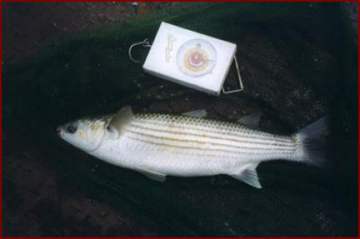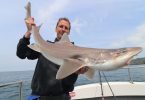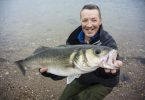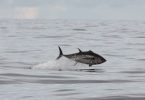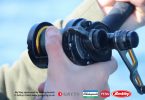The daffodil flowers faded not so long ago. Now their leaves are starting to wither untidily among the long weedy grass stems. I shan’t cut them just yet, not if I want an even better display next year.
Most of the buds on the surrounding trees have exploded into a green haze, among the branches that looked so bare just a few days ago, and the temperature of the water in the estuary has passed that magic figure….10C.
Spring is always a time of excitement as dormant life begins again, the days grow longer and the weather milder. But for one group of people, or should I say one group of special anglers, the excitement mounts more quickly, for it is now that the mulleteers’ season is about to begin.
The magic temperature above which mullet start to feed is 10C.

A mullet takes nearly 15 years to grow to just 3lb. A female does not start to spawn until her 10th year, and then she is likely to spawn just one year in three. A single boat, netting a harbour or bay can destroy sport for many years.
Those tempted to fish for mullet for the pot, or to buy them at £1.68 per lb from the supermarket fish counter should consider those statistics carefully.
Consider the pesticides and heavy metals which a mullet has built up in its flesh from many years of sucking mud from the bottom, and in particular from near the outfalls of sewage works. Mullet don’t even taste that good, at least not unless prepared and served in those delicious sauces in which the Chinese chefs, in particular, excel.
I’ve no ethical problem with anglers catching fish for the table, I have a liking for sea caught eels (again not too many because of the way their bodies store heavy metals and pesticides), sole, dabs, plaice, mackerel, and the few cod which escape the commercial nets. But mullet, for both your health and for the sake of future sport, should always be returned. Incidentally, it is now illegal for any angler to sell their catch.
For most sea anglers, as far as mullet are concerned, this will never be an issue. They lack the tackle and knowledge to ever catch a mullet. Tormented by the frequent sight of large fish swimming around their boats, or beneath the wooden pier, from which they cast their heavy leads, the myth has grown that mullet are uncatchable. ‘They don’t take bait’ they say. ‘Their lips are too soft’.
Well, they do take bait; bread, sweet corn, maggots, mackerel, sausage meat, harbour rag. All have often accounted for mullet. These are baits not often used by sea anglers.
As for soft lips, anyone who has removed a barbed size 8 from a mullet’s lips will tell you otherwise.
So, 10C. I’ve been measuring the sea temperature for the last few weeks. I’ve heard reports that mullet have been seen in the estuary, close by. It will soon be time to start my preparations for this season’s campaign.
Mullet frequenting busy places, harbours, tidal rivers passing through towns, close to sewage works perhaps, are used to feeding on scraps. Especially places where parents take their children to feed the swans, or ducks, or even the herring gulls. These mullet, when fished for properly will readily take ‘exotic’ baits such as bread.
The ‘wild’ mullet, frequenting hidden creeks need to be educated.
There are three species of mullet in the waters surrounding Great Britain. The thick lipped (happily both the most common and the largest), the Thin lipped, and the rare golden grey. It is the Thin-lipped that ventures furthest from the sea, practically into fresh water.
These are the fish that can often be taken on small Mepps spinners, especially when baited with harbour rag.
The thick lipped, which also ventures a long way from the sea, is most likely to be taken using bread or sweetcorn.
The mullet’s natural food is far too small to be placed on a hook. You will often see them skimming the surface. In fact they are feeding on the surface film. Often they will suck in mud, digesting out the small microscopic creatures and plants. They have a specially adapted digestive system, and are famous for the length of their intestines. Sometimes you will see them sucking at the green slimy weed, coating a harbour wall.
These ‘wild’ Mullet know little of bread.
So my preparations start weeks earlier, begging onion and brussel-sprout sacks from the greengrocers. These are then filled with sliced bread, weighted with stones and placed below the high tide line, where I will be fishing in the weeks to come.
As each tide washes the bags, small particles of bread are steadily released downstream. An eye needs to be kept on the sacks, to see when the bread needs replacing. Only white bread will do. Mullet are totally disinterested in healthy brown and/or wholemeal bread.
Now comes the time to fish for the Mullet.
Anyone with a waggler rod, capable of handling big Tench or 4lb carp, is well equipped. Fish bread on a size 8 hook beneath a shotted float, using a float as small as conditions allow.
Mullet are wary and finicky feeders. They can be extremely line shy. For experienced coarse anglers, these will be the most challenging of fish.
 Do not underestimate the fighting quality of these fish. I am used to fishing for and playing Chub and Tench, and even the odd Carp. These do not prepare you for the battle with Mullet. Not the dogged fight of a Tench, the powerful runs of a small carp, or the cunning of a dog Chub.
Do not underestimate the fighting quality of these fish. I am used to fishing for and playing Chub and Tench, and even the odd Carp. These do not prepare you for the battle with Mullet. Not the dogged fight of a Tench, the powerful runs of a small carp, or the cunning of a dog Chub.
I have heard mullet described as turbo charged Chub on steroids, even this doesn’t really describe the their awesome power. Be prepared for their long powerful runs.
Then they have a ‘trick’ of ‘slamming’ the line. I’m not sure what it is they are doing, but on light tackle it is scary. Just when you think you have the measure of them, it’s then they choose to put on the turbos and the afterburners together.
You need a forgiving rod, and a clutch set very lightly, because you will not have time to react to the suddenness of one of these powerful rushes. They will strip line from reel and would have you cursing, except you’ll be far too busy.
When you finally get the fish near you, and lift its head from the
water, do not relax. It isn’t over yet, not by a long way.
But most of all, beware the moment when you attempt to net the fish, the rod held high, on shortened line. This is the most dangerous moment of all.
And to deal with all this power, you are denied the use of big hooks and strong line, that is if you want bites in the first place. No wonder so many sea anglers regard mullet as uncatchable!
It’s these lessons learned from past seasons that fill my mind now, as I look out along the creek toward the estuary. The tide is rippling in along the mudflats, lifting the seaweed and waving the fronds.
As the sun sinks lower, and the evening air stills, I see it. An arrowhead sketched in the still surface of the returning sea. It veers left and is gone. But there’s another and, over there, another. The mullet, they are back, and they are feeding.
Early in the season, when they swim in large shoals, they are most difficult to tempt. Later, when they are swimming in two’s or threes, they will be a little easier, but not much.
I know that shoals will pass my baited line in close formation, frustrating me with their complete disregard. But I also know that the moment will come when that float will dip, I’ll connect and there will be nothing else that matters, except me, the mullet, and the thin and tenuous line between us both.
But for now, I’m happy to watch them as they make their way down the creek, investigating each feature, probing each clump of weed.
As I make my way back to the car, with bats flitting across the darkening sky, the excitement grows, the mullet are back, and summer’s nearly here.
Leon Roskilly

